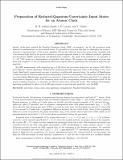Preparation of reduced-quantum-uncertainty input states for an atomic clock
Author(s)
Schleier-Smith, Monika Helene; Leroux, Ian Daniel; Vuletic, Vladan
DownloadSchleier-Smith-2009-Preparation of reduced-quantum-uncertainty input states for an atomic clock.pdf (830.7Kb)
PUBLISHER_POLICY
Publisher Policy
Article is made available in accordance with the publisher's policy and may be subject to US copyright law. Please refer to the publisher's site for terms of use.
Terms of use
Metadata
Show full item recordAbstract
Atomic clocks have reached the Standard Quantum Limit (SQL) of precision,1 set by the projection noise inherent in measurements on uncorrelated atoms. It is possible to overcome this limit by entangling the atoms to generate a "squeezed state" of the atomic ensemble. We use the collective interaction of an atomic ensemble with a far-detuned light field in an optical resonator to prepare squeezed states by two different methods: quantum non-demolition (QND) measurement and Hamiltonian evolution. We apply both methods to an ensemble of 5 x 10[superscript 4] [superscript 87]Rb atoms in a superposition of hyperfine clock states. We measure the suppression of projection noise and compare it to the accompanying reduction in signal, thereby quantifying the net gain in spectroscopic sensitivity. By QND measurement, with resolution up to 9 dB below the projection noise level, we achieve 3.0(8) dB of metrologically relevant squeezing. Whereas the measurement-based approach relies on knowledge of the (randomly distributed) measurement outcome to produce a conditionally squeezed state, the method of Hamiltonian evolution produces a known squeezed state independent of detector performance. We mimic the dynamics of the one-axis twisting Hamiltonian, proposed as a generator of squeezed states by Kitagawa and Ueda, by using the atom-induced frequency shift of the resonator mode and the corresponding resonator-field-induced shift of the atomic transition frequency to introduce an effective interaction among the atoms. The resulting deterministic squeezing is sufficient to allow a 6.0(4) dB improvement in spectroscopic sensitivity over the SQL
Date issued
2009-08Department
Massachusetts Institute of Technology. Department of Physics; Massachusetts Institute of Technology. Research Laboratory of ElectronicsJournal
Proceedings of SPIE--the International Society for Optical Engineering
Publisher
Society of Photo-optical Instrumentation Engineers
Citation
Schleier-Smith, M. H., I. D. Leroux, and V. Vuletic. “Preparation of reduced-quantum-uncertainty input states for an atomic clock.” Time and Frequency Metrology II. Ed. Tetsuya Ido & Derryck T. Reid. San Diego, CA, USA: SPIE, 2009. 743107-10. © 2009 SPIE
Version: Final published version
Other identifiers
SPIE CID: 743107-10
ISSN
0277-786X